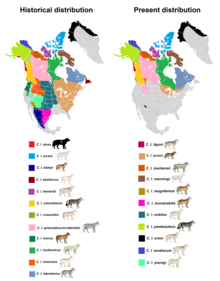
There are 38 subspecies of Canis lupus listed in the taxonomic authority Mammal Species of the World. These subspecies were named over the past 250 years, and since their naming, a number of them have gone extinct. The nominate subspecies is the Eurasian wolf.

The Arctic wolf, also known as the white wolf, polar wolf, and the Arctic grey wolf, is a subspecies of grey wolf native to the High Arctic tundra of Canada's Queen Elizabeth Islands, from Melville Island to Ellesmere Island. Unlike some populations that move between tundra and forest regions, Arctic wolves spend their entire lives north of the northern treeline. Their distribution to south is limited to the northern fringes of the Middle Arctic tundra on the southern half of Prince of Wales and Somerset Islands. It is a medium-sized subspecies, distinguished from the northwestern wolf by its smaller size, its whiter colouration, its narrower braincase, and larger carnassials. Since 1930, there has been a progressive reduction in size in Arctic wolf skulls, which is likely the result of wolf-dog hybridization.

The tundra wolf, also known as the Turukhan wolf, is a subspecies of grey wolf native to Eurasia's tundra and forest-tundra zones from Finland to the Kamchatka Peninsula. It was first described in 1792 by Robert Kerr, who described it as living around the Yenisei, and of having a highly valued pelt.

The northwestern wolf, also known as the Mackenzie Valley wolf, Alaskan timber wolf, or Canadian timber wolf, is a subspecies of gray wolf in western North America. Arguably the largest gray wolf subspecies in the world, it ranges from Alaska, the upper Mackenzie River Valley; southward throughout the western Canadian provinces, aside from prairie landscapes in its southern portions, as well as the Northwestern United States.
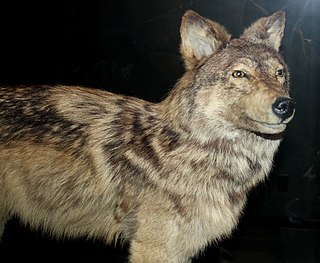
The Newfoundland wolf was a subspecies of grey wolf that was native to Newfoundland. As a food source, the species would prey and rely on the Newfoundland caribou. During the autumn and early winter, some wolves would turn white while others remained dark enough to look black.
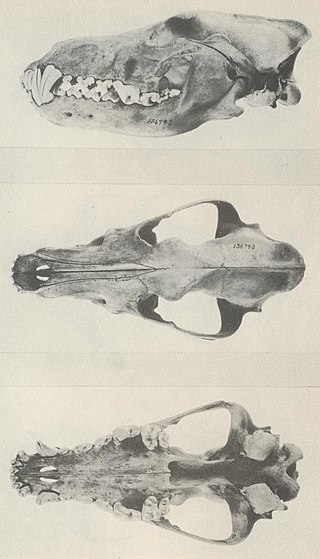
The Kenai Peninsula wolf, also known as the Kenai Peninsula grey wolf, is an extinct subspecies of the gray wolf that lived on the Kenai Peninsula in southern Alaska.

Bernard's wolf, also known as the Banks Island wolf or the Banks Island tundra wolf, is an extinct subspecies of the gray wolf that was limited to Banks and Victoria Island of the Arctic Archipelago.

The British Columbia wolf is a subspecies of gray wolf which lives in a narrow region that includes those parts of the mainland coast and near-shore islands that are covered with temperate rain-forest, which extends from Vancouver Island, British Columbia, to the Alexander Archipelago in south-east Alaska. This area is bounded by the Coast Mountains.

The Florida black wolf, also known as the Florida wolf and the black wolf, is an extinct subspecies of red wolf that was endemic to Florida.
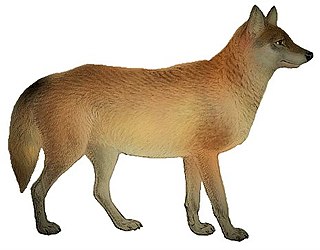
The Cascade mountain wolf is an extinct subspecies of the gray wolf that was once found in the Pacific Northwest, but became extinct in 1940.
Gregory's wolf, also known as the Mississippi Valley wolf, was a subspecies of the red wolf. It was declared extinct in 1980. It once roamed the regions in and around the lower Mississippi River basin.

The Hudson Bay wolf is a subspecies of gray wolf native to the northern Kivalliq Region, including the northwestern coast of Hudson Bay in Canada. It was first classed as a distinct subspecies in 1941 by Edward Goldman, who described it as being a white colored, medium-sized subspecies similar to C. l. arctos, but with a flatter skull. This wolf is recognized as a subspecies of Canis lupus in the taxonomic authority Mammal Species of the World (2005).

The Labrador wolf is a subspecies of gray wolf native to Labrador and northern Quebec. It has been described as ranging in color from dark grizzly-gray to almost white, and of being closely related to the Newfoundland wolf. This wolf is recognized as a subspecies of Canis lupus in the taxonomic authority Mammal Species of the World (2005).
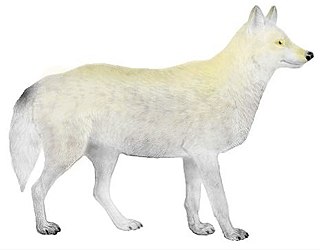
The Baffin Island wolf, also known as the Baffin Island tundra wolf, is a subspecies of grey wolf which resides exclusively on Baffin Island and several nearby islands. It was not formally recognized as a subspecies until 1943, when it was given its taxonomic classification by Anderson. This wolf is recognized as a subspecies of Canis lupus in the taxonomic authority Mammal Species of the World (2005).

The Mogollon mountain wolf is an extinct subspecies of gray wolf whose range once included Arizona and New Mexico. It is darker than its more northern cousins, and has a highly arched frontal bone.

The Texas wolf is an extinct subspecies of gray wolf, distinct from the Texas red wolf, whose range once included southern and western Texas and northeastern Mexico.

The Greenland wolf is a subspecies of gray wolf that is native to Greenland. Historically, it was heavily persecuted, but today it is fully protected and about 90% of the wolf's range falls within the boundaries of the Northeast Greenland National Park.
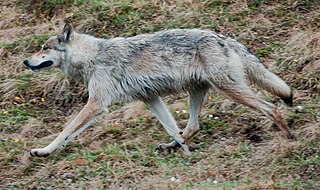
The Interior Alaskan wolf, also known as the Yukon wolf, is a subspecies of gray wolf native to parts of British Columbia, the Northwest Territories, Interior Alaska and Yukon.

The southern Rocky Mountain wolf is an extinct subspecies of gray wolf which was once distributed over southeastern Idaho, southwestern Wyoming, northeastern Nevada, Utah, western and central Colorado, northwestern Arizona, and northwestern New Mexico. It was a light-colored, medium-sized subspecies closely resembling the Great Plains wolf, though larger, with more blackish-buff hairs on the back. This wolf went extinct by 1935. Wolves of the subspecies Canis lupus occidentalis have now been reestablished in Idaho and Wyoming.

The Mongolian wolf is a subspecies of gray wolf which is native to Mongolia, northern and central China, Korea, and the Ussuri region of Russia.

